The Electrophoresis Reagents Market is estimated to be valued at USD 2.9 billion in 2025 and is projected to reach USD 4.8 billion by 2035, registering a compound annual growth rate (CAGR) of 5.1% over the forecast period.
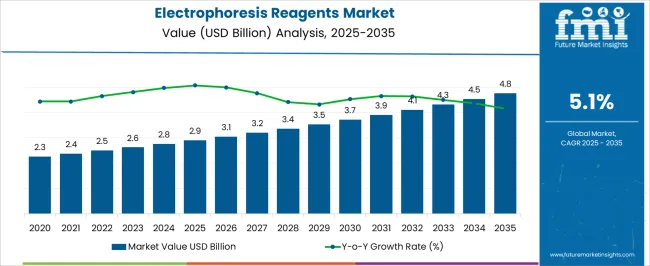
| Metric | Value |
|---|---|
| Electrophoresis Reagents Market Estimated Value in (2025 E) | USD 2.9 billion |
| Electrophoresis Reagents Market Forecast Value in (2035 F) | USD 4.8 billion |
| Forecast CAGR (2025 to 2035) | 5.1% |
The Electrophoresis Reagents market is expanding steadily, driven by the increasing need for advanced molecular biology techniques across research, diagnostics, and industrial applications. Electrophoresis remains a fundamental process for separating and analyzing nucleic acids and proteins, and reagents are essential to ensure accuracy, sensitivity, and reproducibility. The rising prevalence of genetic disorders and cancers has intensified the demand for electrophoresis in clinical laboratories, while ongoing drug discovery initiatives are supporting broader utilization in pharmaceutical and biotechnology sectors.
Advances in electrophoresis technologies, including automated systems and next-generation gel formulations, are further boosting efficiency and reliability. Additionally, academic and research institutions are playing a critical role in sustaining demand as they adopt electrophoresis reagents for educational training and experimental research.
Increasing global investment in life sciences, genomics, and proteomics is reinforcing the long-term relevance of these reagents As the focus on personalized medicine and precision diagnostics grows, the electrophoresis reagents market is expected to remain a vital enabler of biological research and clinical testing, supported by innovation in product quality and cost-effective solutions.
The electrophoresis reagents market is segmented by product type, end user, and geographic regions. By product type, electrophoresis reagents market is divided into Gels, Dyes, Buffers, and Others. In terms of end user, electrophoresis reagents market is classified into Academic Institutions, Pharmaceutical & Biotechnology Industry, Hospitals, and Diagnostic Centers. Regionally, the electrophoresis reagents industry is classified into North America, Latin America, Western Europe, Eastern Europe, Balkan & Baltic Countries, Russia & Belarus, Central Asia, East Asia, South Asia & Pacific, and the Middle East & Africa.
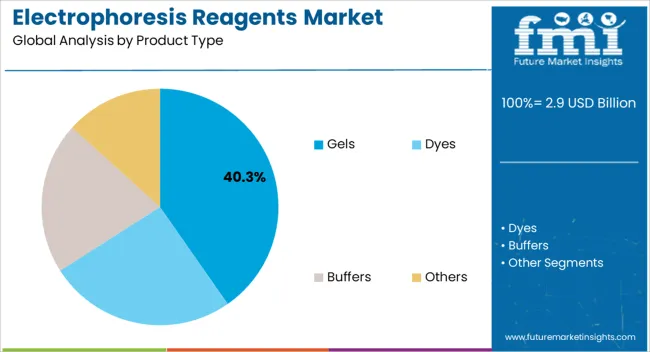
The gels product type segment is expected to hold 40.3% of the electrophoresis reagents market revenue share in 2025, making it the leading product category. Gels continue to dominate due to their proven effectiveness in separating DNA, RNA, and proteins with high resolution and precision. Agarose and polyacrylamide gels remain widely used because of their versatility and reliability in research and diagnostic applications.
Researchers and clinicians prefer gels for their cost-effectiveness, reproducibility, and ease of customization for different experimental needs. The segment is also benefiting from continuous innovations in pre-cast gels and stain-free technologies, which improve convenience and reduce workflow times. Increasing adoption of gels in genetic testing, cancer diagnostics, and proteomics research further strengthens their market leadership.
Their critical role in enabling accurate analysis and interpretation of molecular structures supports consistent demand across academic, clinical, and industrial laboratories As biotechnology and life sciences research continue to advance, gels are anticipated to retain their position as the most widely utilized electrophoresis reagent type.
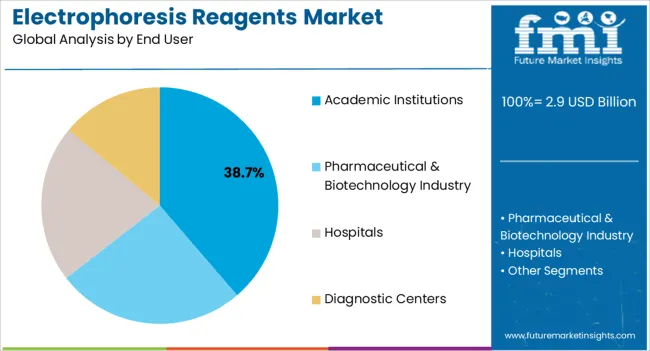
The academic institutions segment is projected to account for 38.7% of the electrophoresis reagents market revenue share in 2025, positioning it as the leading end-user group. Growth in this segment is being driven by the increasing emphasis on research, training, and experimental learning in universities and research institutes worldwide. Electrophoresis reagents are indispensable for teaching molecular biology, genetics, and biochemistry, providing students with hands-on experience in analyzing DNA, RNA, and proteins.
Academic institutions also conduct a significant share of foundational and applied research, supporting advancements in genomics, proteomics, and biotechnology. Government funding, international collaborations, and expanding life sciences education programs are further boosting the adoption of electrophoresis reagents in this sector.
The availability of advanced research infrastructure in leading universities and growing investment in laboratory facilities across emerging economies are strengthening the segment’s role As global demand for skilled researchers rises, academic institutions are expected to remain a primary driver of electrophoresis reagent consumption, ensuring sustained growth for this market segment.
Electrophoresis is a technique used for separation of DNA, RNA and Protein based on their size and charge. The techniques is used to determine the size and type of macromolecules from the sample. The techniques is based on application of electric charge at the ends of the assembly into which gel loaded with fluorescence dyes attached to sample is placed.
Depending upon the charge of the sample the macromolecules migrate from one end towards the other. After the process is completed the gel is placed under UV light source to see the bands formed my migration of the macromolecules.
Electrophoresis has wide applications like identification of molecular markers in genotyping of the organism species, for verifying amplification of gene sequences, to check quality and quantity of DNA, RNA and Protein samples after extraction and to separate DNA fragments in cloning.
Owing to increasing focus on biological therapies the based on alteration DNA and RNA the use of electrophoresis technique is increasing rapidly which is evidently expected to increase demand for electrophoresis reagents over the forecast period.
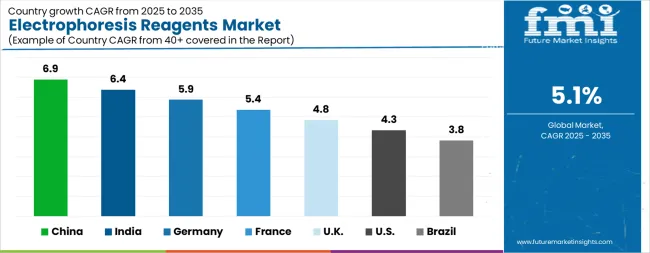
| Country | CAGR |
|---|---|
| China | 6.9% |
| India | 6.4% |
| Germany | 5.9% |
| France | 5.4% |
| UK | 4.8% |
| USA | 4.3% |
| Brazil | 3.8% |
The Electrophoresis Reagents Market is expected to register a CAGR of 5.1% during the forecast period, exhibiting varied country level momentum. China leads with the highest CAGR of 6.9%, followed by India at 6.4%. Developed markets such as Germany, France, and the UK continue to expand steadily, while the USA is likely to grow at consistent rates. Brazil posts the lowest CAGR at 3.8%, yet still underscores a broadly positive trajectory for the global Electrophoresis Reagents Market. In 2024, Germany held a dominant revenue in the Western Europe market and is expected to grow with a CAGR of 5.9%. The USA Electrophoresis Reagents Market is estimated to be valued at USD 1.1 billion in 2025 and is anticipated to reach a valuation of USD 1.6 billion by 2035. Sales are projected to rise at a CAGR of 4.3% over the forecast period between 2025 and 2035. While Japan and South Korea markets are estimated to be valued at USD 146.9 million and USD 82.7 million respectively in 2025.
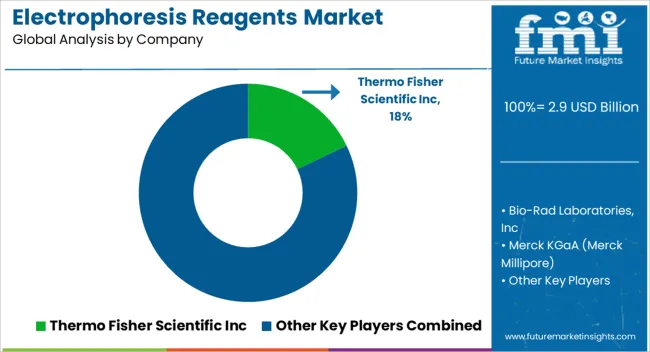
| Item | Value |
|---|---|
| Quantitative Units | USD 2.9 Billion |
| Product Type | Gels, Dyes, Buffers, and Others |
| End User | Academic Institutions, Pharmaceutical & Biotechnology Industry, Hospitals, and Diagnostic Centers |
| Regions Covered | North America, Europe, Asia-Pacific, Latin America, Middle East & Africa |
| Country Covered | United States, Canada, Germany, France, United Kingdom, China, Japan, India, Brazil, South Africa |
| Key Companies Profiled | Thermo Fisher Scientific Inc, Bio-Rad Laboratories, Inc, Merck KGaA (Merck Millipore), Agilent Technologies Inc, GE Healthcare, Sigma-Aldrich Corporation, Lonza Group Ltd, Promega Corporation, Takara Bio Inc., and QIAGEN N.V. |
The global electrophoresis reagents market is estimated to be valued at USD 2.9 billion in 2025.
The market size for the electrophoresis reagents market is projected to reach USD 4.8 billion by 2035.
The electrophoresis reagents market is expected to grow at a 5.1% CAGR between 2025 and 2035.
The key product types in electrophoresis reagents market are gels, dyes, buffers and others.
In terms of end user, academic institutions segment to command 38.7% share in the electrophoresis reagents market in 2025.






Our Research Products

The "Full Research Suite" delivers actionable market intel, deep dives on markets or technologies, so clients act faster, cut risk, and unlock growth.

The Leaderboard benchmarks and ranks top vendors, classifying them as Established Leaders, Leading Challengers, or Disruptors & Challengers.

Locates where complements amplify value and substitutes erode it, forecasting net impact by horizon

We deliver granular, decision-grade intel: market sizing, 5-year forecasts, pricing, adoption, usage, revenue, and operational KPIs—plus competitor tracking, regulation, and value chains—across 60 countries broadly.

Spot the shifts before they hit your P&L. We track inflection points, adoption curves, pricing moves, and ecosystem plays to show where demand is heading, why it is changing, and what to do next across high-growth markets and disruptive tech

Real-time reads of user behavior. We track shifting priorities, perceptions of today’s and next-gen services, and provider experience, then pace how fast tech moves from trial to adoption, blending buyer, consumer, and channel inputs with social signals (#WhySwitch, #UX).

Partner with our analyst team to build a custom report designed around your business priorities. From analysing market trends to assessing competitors or crafting bespoke datasets, we tailor insights to your needs.
Supplier Intelligence
Discovery & Profiling
Capacity & Footprint
Performance & Risk
Compliance & Governance
Commercial Readiness
Who Supplies Whom
Scorecards & Shortlists
Playbooks & Docs
Category Intelligence
Definition & Scope
Demand & Use Cases
Cost Drivers
Market Structure
Supply Chain Map
Trade & Policy
Operating Norms
Deliverables
Buyer Intelligence
Account Basics
Spend & Scope
Procurement Model
Vendor Requirements
Terms & Policies
Entry Strategy
Pain Points & Triggers
Outputs
Pricing Analysis
Benchmarks
Trends
Should-Cost
Indexation
Landed Cost
Commercial Terms
Deliverables
Brand Analysis
Positioning & Value Prop
Share & Presence
Customer Evidence
Go-to-Market
Digital & Reputation
Compliance & Trust
KPIs & Gaps
Outputs
Full Research Suite comprises of:
Market outlook & trends analysis
Interviews & case studies
Strategic recommendations
Vendor profiles & capabilities analysis
5-year forecasts
8 regions and 60+ country-level data splits
Market segment data splits
12 months of continuous data updates
DELIVERED AS:
PDF EXCEL ONLINE
Electrophoresis Market Trends - Growth, Demand & Forecast 2025 to 2035
Electrophoresis Equipment and Supplies Market Analysis
Electrophoresis Transilluminator Market
Microchip Electrophoresis Market Size and Share Forecast Outlook 2025 to 2035
Capillary Electrophoresis Market Size, Growth, and Forecast 2025 to 2035
Sequencing Electrophoresis Systems Market Size and Share Forecast Outlook 2025 to 2035
Nucleic acid electrophoresis and blotting market
DNA Sequencing Electrophoresis Systems Market
High Current Power Supply for Electrophoresis Market Size and Share Forecast Outlook 2025 to 2035
Grignard Reagents Market Demand & Trends 2022 to 2032
Flotation Reagents Market Size and Share Forecast Outlook 2025 to 2035
Myoglobin Reagents Market
Sequencing Reagents Market
Fructosamine Reagents Market
Beneficiation Reagents Market Size and Share Forecast Outlook 2025 to 2035
Lipase Testing Reagents Market Size and Share Forecast Outlook 2025 to 2035
Urinary Protein Reagents Market
Magnesium Testing Reagents Market
Hematology Analyzer And Reagents Market
Eco-friendly Beneficiation Reagents Market Size and Share Forecast Outlook 2025 to 2035

Thank you!
You will receive an email from our Business Development Manager. Please be sure to check your SPAM/JUNK folder too.
Chat With
MaRIA